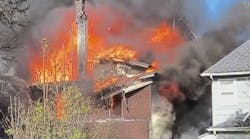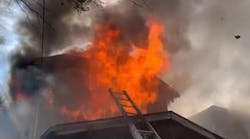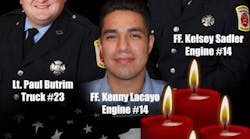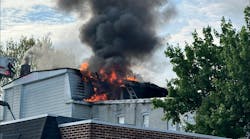You see the coast-to-coast email notifications every day. A 50-year-old is involved in a motor vehicle accident; another suffers a heart attack; a 31-year-old is diagnosed with a medical condition; someone commits suicide; another falls into the trap of substance abuse.
As I type this, I see notifications from New York, Michigan, South Carolina and California. In my international NFPA travels, this is not unheard of; however, the frequency is far less in other countries than it is in the United States.
I'm not just talking about line-of-duty deaths (LODDs)—I’m also talking about close calls.
Health issues
We already know the majority of our LODDs are medical conditions. And a large number of those are fully within our control. Yet we continue to see our folks “drop like flies” and, effectively, we do little about it. I put the majority of this on the chiefs—including myself—the leaders of our organizations. We’ve heard the excuses before: “I’m EMS only, so I don’t have to be as in-shape as a firefighter.” “I’m a volunteer, you can’t tell me what to do!” “You can’t fire me!” “So, I’m a little overweight, all I want to do is help.” Physical fitness and healthy lifestyles are critical to improving our death and injury statistics. A beer belly is NOT a badge of honor. When is enough, enough?
Vehicle incidents
Vehicle accidents—not wearing seatbelts, rollovers, dangerous intersections and "struck-bys"—are next on the list. Seatbelts should be easy, but the other items aren’t necessarily as easy for us to control. However, many instances could be avoided through improved training and/or awareness—and that is FULLY within our control. Seatbelts, turn signals, wheel chocks, speeding, distracted driving, unsafe lane changing—we CAN control ALL of this! When is enough, enough?
Dangerous conditions
Burn injuries, falling through floors, slips/trips/falls, back strains, muscle pulls. Let's face it, firefighting is an inherently unsafe business—one where we put our people in harm’s way, on purpose. That purpose does not mean death or injury are inevitable! While injuries or deaths occurring during firefighting or rescue operations are a distinct possibility, all too often we are putting people in (or allow them to put themselves in) situations that should not warrant the risk or our presence at all.
My own department culture has been difficult to change. We just recently had three firefighters suffer burns in a situation that did NOT have to happen. Among other issues on the incident, a transitional exterior attack would have significantly reduced the likelihood that there would have been any injuries. When asked why they did not use the transitional tactic, the answer was, “We didn’t want to be called ‘wimps.’” Now asking myself, when is enough, enough? Our new Order is on its way. In the meantime, one firefighter may never return to duty. He may never have to worry about being a “wimp” again. Was it worth it?
Mental health
We only scratch the surface of suicide in the fire and EMS service. How many of us are even talking about it? How many of us have an intervention program or EFFECTIVE employee assistance programs (EAPs) to prevent the next suicide from happening? As much as my CISM friends will not like this statement, critical incident stress management is NOT truly our forte! We should look at available resources to help each other. At a recent leadership meeting, the Veterans Administration was touted as a reasonable and experienced place to start. The VA does certainly have the experience with CISM and PTSD; however, I also recognize the VA resources are stretched as thin or thinner as the rest of us. If the VA is an option for you, take the time to look into services they may share.
Peer and spiritual support teams among and within departments are another resource to make differences. Departments and individuals have to take this seriously and take the right steps. Start by ASKING FOR HELP.
Strategy and tactics
In a previous column we talked about flow-path science. How many of you still primarily approach the basement fire from the interior steps above the fire? If anyone raised their hand or said “yes,” what are you waiting for? When is enough, enough? If you're one of those still bucking that trend, then I guarantee you that you too will be making unnecessary trips to the burn center or morgue unit to see one or more of your folks. How will you answer to the families who suffer 100 times worse than you will? What will your answer be when THEY ask the question, “When is enough, enough?” Take your head out of the sand because the answer to that scenario is that "this did not have to happen." Physically approaching the basement fire differently is only one part of understanding flow paths; however, that approach alone would have prevented two significant injuries for our department. I am happy to say we now approach basement fires differently.
Ventilation control and putting water on the fire are two other news flashes that seem pretty counter-intuitive for me to even bring up, yet I bet there are more people who will raise their hands to say they would NEVER lob water in the window from the outside or they will ALWAYS send someone to the roof. How many more videos do we need to watch of firefighters ascending a ladder to the residential roof where fire is already pushing through multiple points, just to see those same firefighters drop through that weakened roof to an abyss below? Time to make more visits to burn units and morgues.
It all comes back to leadership
Leadership comes in many forms and does not have to only come from the chief. Each and every one of us has a responsibility to influence each other to make a difference, inspiring others to achieve their greatest potential. That transformation can’t happen if you or your folks don’t make it to tomorrow. As I finish this article while in the shadows of the annual National Fallen Firefighters Memorial Service, I ask again, when is enough, enough?






